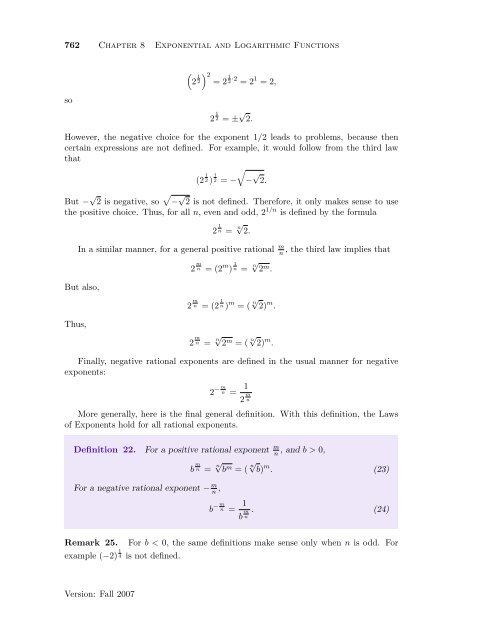Section 1: Exponents and Roots
Section 1: Exponents and Roots
Section 1: Exponents and Roots
You also want an ePaper? Increase the reach of your titles
YUMPU automatically turns print PDFs into web optimized ePapers that Google loves.
762 Chapter 8 Exponential <strong>and</strong> Logarithmic Functionsso( )2 1 2 12 = 2 2 ·2 = 2 1 = 2,2 1 2 = ±√2.However, the negative choice for the exponent 1/2 leads to problems, because thencertain expressions are not defined. For example, it would follow from the third lawthat(2 1 2 )12 = −√− √ 2.But − √ 2 is negative, so √ − √ 2 is not defined. Therefore, it only makes sense to usethe positive choice. Thus, for all n, even <strong>and</strong> odd, 2 1/n is defined by the formula2 1 n =n √ 2.In a similar manner, for a general positive rational m n, the third law implies thatBut also,Thus,2 m n = (2 m ) 1 n =n √ 2 m .2 m n = (21n ) m = ( n√ 2) m .2 m n =n √ 2 m = ( n√ 2) m .Finally, negative rational exponents are defined in the usual manner for negativeexponents:2 − m n =12 m nMore generally, here is the final general definition. With this definition, the Lawsof <strong>Exponents</strong> hold for all rational exponents.Definition 22. For a positive rational exponent m n, <strong>and</strong> b > 0,For a negative rational exponent − m n ,b m n =n √ b m = ( n√ b) m . (23)b − m 1n = . (24)b m nRemark 25. For b < 0, the same definitions make sense only when n is odd. Forexample (−2) 1 4 is not defined.Version: Fall 2007
















